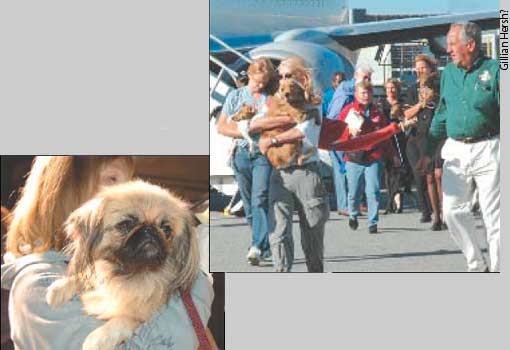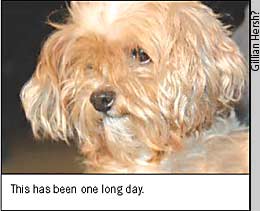November 2005
Operation: Orphans of the Storm

Rescuing forgotten citizens
by Pete Alexander
It has been, and continues to be a huge effort, and unprecedented. When the big wind came, and water then overwhelmed the city of New Orleans, many pets were left behind, as people were not allowed to bring them with when being rescued. Word of this was apparent to all who watched the events unfold, and some could not sit by and do nothing. Giant hearts and willing hands began to reach out to rescue these forgotten world citizens.
Bill McLaughlin, a Tiburon resident, got it all started, what became called by the Marin Humane Society "Operation: Orphans of the Storm." Bill communicated with various agencies in the North Bay to see if they would be able to handle the animals, then began to line up larger C-130 planes to transport the animals to the Bay Area. Among those who are helping fund the effort are the Solomon Family Foundation, Texas oilman T. Boone Pickens, and his wife Madeleine from Texas, and Continental Airlines, which is providing the planes at cost with volunteer crews. In fact, flight crew members have taken the animals out of their crates, and bathed them in flight, and many of them wanted to immediately adopt their favorites.
The four North Bay agencies initially involved are the Marin Humane Society (MHS), the Command Center of the Operation, Pets Lifeline (PL), Humane Society of Sonoma County (HSSC) and Countryside Rescue (CR). The people in each of these had a common reaction to the crisis: we will do whatever it takes, we will not say ‘no’ to any, and we will solve problems as they come up. People in the communities responded en masse with offers of donations, supplies, and volunteer labor. What an amazing and caring attitude: would that many governmental agencies would adopt this spirit. As Susan Simons of Pets Lifeline said, "There was a very positive collaboration, a bringing of people [from the agencies] together. " Michele Mussen of CR says, "It was a great support group effort; all worked together very cooperatively."
Animals on the tarmac

Soon planes were arriving, the first on September 11. Agency representatives were there to pick up the animals assigned them. From that flight, HSSC got 12 animals, for example. Other agencies got their allotments, and off all drove to get them to a safe place, assess their conditions and begin the treatment they would need. As of September 29, MHS had approximately 150 animals, about 15% of them cats, PL had 33, of them 22 dogs, CR had 16, 6 of them cats, and HSSC had 31, of those 25 are dogs. Since then, they have received more animals as the flights keep arriving, with some animals now also coming from the area of Rita’s destruction. Was there more of a specific breed arriving? Although there were a number of Bull Terrier and Bull Terrier mixes, the make-up was a complete variety of large and small dogs. Angie Bonnert of HSSC reported that all the dogs were extremely well-behaved.

What kind of problems have these animals had? Many showed up with heartworm, a very costly and lengthy treatment program. Heartworm is a preventable disease (just a pill a month), and in an area with lots of mosquitoes (the carrier) in the storm region, one wonders why so many animals had not been medicated. The agencies found lots of ringworm, a fungal disease which takes 4-8 weeks to cure, in both dogs and cats. Affected animals must be isolated for this period since ringworm is highly contagious). Some of the dogs had kennel cough. Many dogs were dehydrated. Why, with so much water around? The animals most likely would drink the foul water, get diarrhea, and then dehydrate. A discovery of note is that most of the animals had not been neutered or spayed.
Treatment began right away, with some animals being sent to other areas with the appropriate facilities. Some of the animals are being fostered at volunteer homes, though ringworm patients must stay isolated at the kennels. All the animals were cleaned and fed and began right away to increase weight and look better. Soon, some of the animals got to go to foster homes.
How do we find the owners?
The main effort beyond treatment and care is the location of the animals’ owners. The website www.petfinder.com is the place for owners to look. Owners are being found and what wonderful reunions. Sheri Cardo of MHS reports that a Springer Spaniel mix girl named Lady, got lost during the storm and ended up at MHS. She was found on Petfinder.com by one of the owners. Lady was reunited with Dr. Brinda Singh in Marin County, and what a great moment! Tia, a black Toy Poodle, was ripped from the arms of her owner as she was boarding a bus on a causeway, and she thought she would never see her again. They looked on the website, found her picture, called, and Tia was soon headed back on the lap of a volunteer to be reunited with her owner.
Some owners may never be found, and the animals will have to have new homes. Some will be adopted by volunteer foster families (they will have to wait until December 30 before that can take place), but some will not. All the agencies would like you to come visit, see the animals, not just the Katrina and Rita dogs and cats, and open your heart to adopting.
Big thanks
The Marin Humane Society, the Humane Society of Sonoma County, Pets Lifeline and Countryside Rescue all expressed an immense thank you to the community for their overwhelming support, the volunteers who gave so much time, and their staff members who dropped everything to solve problems and make this such an ongoing success.
There is lots you can do to support this effort, which will continue at least for two months or longer (see sidebar). Money is top on the list, so crack open your wallet and give what you can. Second on the list is a need for people to adopt animals. Come to your local shelter, see the "real deal" (as Susan Simons puts it), see what you can do to make a difference, to make the lives of our North Bay homeless animals so much better.

